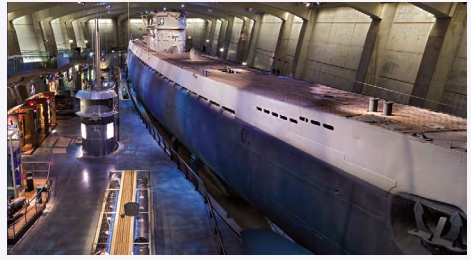Fateful Encounter: The Guadalcanal and the U-Boat
The captured German U-505 submarine now sits in the Museum of Science and Industry in Chicago.
On June 4 , 194 4 , while Rome was being liberated by allied forces, the U.S.S. Guadalcanal was the command ship of task group 22.3 engaged in anti-submarine warfare for the Atlantic f leet. About 150 miles off Cape Blanco of French West Af rica, an escor t destroyer, the U.S.S. Chatelain, made sonar contact with a German submarine. It was later identified as the U-505, a large-class German vessel of the IX-C t ype.
Task Force Captain Daniel V. Galler y gave an order to tr y to capture the sub by forcing it to the sur face with depth charges f rom the U.S.S. Chatelain and with machine gun fire f rom t wo Wildcat fighter planes f lying off the U.S.S. Guadalcanal. When the sub was damaged, the German U-boat captain gave an order to sur face and abandon the crippled but still under way vessel. In the ensuing fire fight with the t wo planes and the escor t destroyer, one German was killed and 16 were wounded out of the 59 men on board. No Americans were killed or injured.
Lieutenant Alber t David, the engineering officer from another escor t destroyer, the U.S.S. Pillsbur y, then led an armed boarding par t y of nine sailors into the sub interior where they found no one aboard. In the meantime, Captain Galler y ordered 37-year-old Commander Trosino to take a crew of specialized ser vice men to board and salvage the sinking U-boat, even though Trosino had never been inside a submarine before. Taking eight hand-picked sailors with him in a motorized whale boat, Trosino and the group headed for the German sub. Upon reaching the U-505, due to the inexperience of the boat crew in rough waters, a large wave lif ted them onto the for ward deck of the sub and the sailors jumped out. The next wave capsized the boat and all of their salvage equipment, except for a camera and a first aid kit, were dumped into the ocean.
Since the U-boat was still going under way in a wide circle and set tling lower by the stern, i.e. the af t end, in the water, an impassable area of ocean water was created bet ween the bow and the conning tower. To reach the conning tower and gain access into the vessel, Trosino grabbed the radio aerial wire strung f rom the conning tower to the bow and pulled himself hand over hand through the bat tering waves up to the top of the conning tower.
Meeting with Lieutenant David, Trosino went below into the slowly sinking sub, leaving his men safe topside. With his knowledge of technical German, he was able to identif y different devices on the bulkheads in each area of the vessel. Aware that perhaps some of the time-delay demolition charges set by the Germans had not been found and deactivated by David’s armed boarding par t y, Trosino and David never theless decided to risk stopping the electric propulsion motors. When the motors stopped turning the twin propellers, the U-boat settled deeper by the stern. Trosino and David saw bilge water rising up the af t bulkhead in the propulsion control room. Realizing that the sub had sunk deeper than anticipated, Trosino went out to request a tow to aquaplane the sub so that ocean water would not cascade down the hatch when opened.
Returning below, Trosino saw that an eightinch diameter strainer was the source of the water rising over the f loor plates in the control room because its cover had been replaced without its gasket by the men of David’s armed boarding par t y. Since the gasket was nowhere to be found, Trosino located a T-wrench and secured the water stop valve, removed the cover, and made a temporar y gasket out of his undershir t. The sub then stopped sinking. For their heroism, David was awarded the Medal of Honor and Trosino received the Legion of Merit with a V (earned during combat). The nine sailors in the armed boarding par t y also received medals. This event was the first time since 1815 that the words “Away boarders!” were heard in the U.S. Nav y, meaning that a boarding par t y was leaving an American ship to capture an enemy man-ofwar in combat.
A s the sub was being towed towards Bermuda, ten mail bags and a sea chest were dispatched by an escor t destroyer to Washington, D.C. They were filled with captured documents, including secret German radio codes for directing U-boat operations. Electric torpedoes, which lef t no tell-tale wakes, were also recovered f rom the sub. Information about them provided some of the most valuable intelligence captured in World War II and helped to shor ten the war in Europe.


